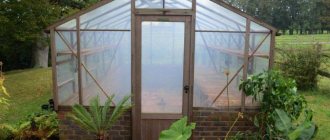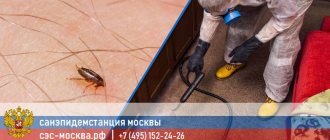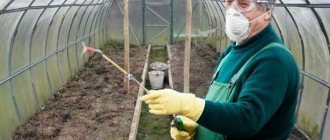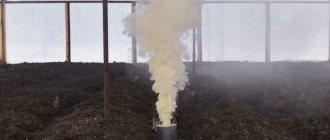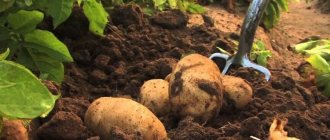Treatment and disinfection of the greenhouse is an important step towards obtaining a good harvest. Capital greenhouses create excellent conditions for the wintering of harmful insects, bacteria, viruses and fungi. In the spring, they attack young plants, preventing them from getting stronger, which leads to partial or complete loss of the harvest.
How to prepare a greenhouse for winter and the next season without harming beneficial insects and the structure itself? Read about it in our article.
Disinfection of a polycarbonate greenhouse in the fall
Content
- Step 1. Cleaning up plant debris
- Step 2. Washing the walls of the greenhouse and equipment
- Step 3. Digging up the greenhouse in the fall
- Step 4. Improving soil composition
- 4.1. Adding compost/vermicompost/humus
- 4.2. Vermiculite
- 4.3. Deoxidation
- Step 5. Application of mineral fertilizers
- Step 6. Disinfection of the greenhouse in the fall
- 6.1. Disinfection of the internal walls of the greenhouse
- 6.2. Treatment of greenhouse soil against phytopathogens
- 5.3 Autumn pest control in the greenhouse
- Step 7. Sowing green manure
- As a conclusion
Processing a greenhouse in the fall is one of the important stages of agrotechnical work. During the season, a lot of effort was spent on fighting late blight, root rot and other fungal and bacterial infections, as well as various insect pests, including soil-dwelling pests. Autumn is the most successful and necessary time for all this work.
In this material we will consider a step-by-step work plan.
Greenhouse treatment in the fall includes:
- Step 1. Cleaning up plant debris;
- Step 2. Washing the walls of the greenhouse and equipment;
- Step 3. Digging (including soil replacement);
- Step 4. Improving the soil composition (adding vermicompost and deoxidation);
- Step 5. Application of mineral fertilizers;
- Step 6. Disinfection (internal walls of the greenhouse with copper-containing preparations, soil treatment against phytopathogenic microflora, soil treatment against soil-dwelling pests, use of smoke bombs, etc.);
- Step 7. Sowing green manure.
And so, in order:
Why do you need to clean your greenhouse in the fall?
Old-time gardeners will say that they never washed or treated the greenhouse and everything grew perfectly. But already in August they were picking the last cucumbers, because the bushes had turned yellow, blackened, and the fruits were rotting. Autumn - you might say. Diseases - experienced gardeners will say.
Preparing a greenhouse in the fall for the next season is necessary in order to:
- get rid of spores of fungal diseases and bacteria;
- destroy insect larvae and bugs that eat plants;
- treat the soil, bring it to the optimal pH;
- enrich the soil in the greenhouse with organic matter and micro-macroelements.
Features of a polycarbonate greenhouse
There were no processing problems with film greenhouses: at the end of the season, summer residents got rid of the film, and the soil was treated as open ground. In the case of polycarbonate greenhouses, the treatment is slightly different.
Firstly, if the frame is metal or galvanized, then the greenhouse cannot be treated with a sulfur bomb, iron sulfate and Farmayod. When these substances come into contact with iron, corrosion will occur. With an aluminum structure, it’s possible.
If you are not sure what the frame is made of, try it on a small piece of the structure before working on the entire greenhouse.
Secondly , always start processing from the soil. If you first wash the walls and then start working on the soil, then spores of fungi and bacteria with dust can get on the polycarbonate and remain over the winter, and in the spring, accordingly, they will start attacking plants.
Thirdly , soil cultivation in closed ground is different: the rate of preparations is doubled. Those. Prepare all consumable medications in double concentration. We will talk about how to treat a polycarbonate greenhouse in the fall later in the article.
Processing a polycarbonate greenhouse in the fall
Let's start the autumn cleaning of the greenhouse. We explain step by step how and with what to clean the greenhouse after harvesting.
We remove all plant debris:
- we collect the remaining harvest;
- Carefully remove the above-ground part of the plant. Do not pull or shake! If it is sick, then carefully cut off the stem and take it out of the greenhouse for burning so that bacteria and fungus remain inside to a minimum;
- collect all weeds and fallen leaves;
- dig up the roots of the plants. Don't leave them in the ground. Remember that late blight spores overwinter on them. No roots - no late blight for next year.
Treating the soil
Always deal with the soil first and then the walls so that bacteria and fungal spores do not settle on the walls during the winter after digging in the dusty soil.
To cultivate the soil in closed ground, we spill one of the following preparations:
- Trichocin, 2 times with an interval of 14 days;
- Fitolavin, once;
- Copper sulfate;
- Inta-Vir;
- Farmayod (in soil only).
We use all drugs according to the instructions, but in double concentration. For example, we dilute Trichocin at 6 grams. for 10 liters, and 12 g. for the same 10 liters. This is an effective treatment for late blight, whitefly and mites in a polycarbonate greenhouse in the fall.
The best option for treating the soil in a greenhouse would be a complete or partial (15 cm) replacement of the soil. But few gardeners can do this every year.
We treat the walls of the greenhouse with preparations, and then wash it
If it seems to you that it does not need washing, then simply treat it. But often after the season, the walls of the greenhouse turn yellow due to the color of the cucumber leaves, which grow high and adhere to the polycarbonate. You can wash it with either a mop or a garden hose.
How to treat polycarbonate greenhouse walls in the fall:
- tar soap;
- tobacco checker;
- alcohol + chlorhexidine (expensive method, but works)
The following drugs kill all living things in the greenhouse, so they are effective, but you can get corrosion of the metal parts of the greenhouse:
- Farmayod;
- Sulfur checker;
- Iron sulfate solution.
Biological preparations such as EM-Bio, Baikal-EM1, Serebromedin also work in treating polycarbonate greenhouse walls, but the solution must be prepared in double concentration.
We increase soil fertility in the greenhouse after processing and washing the walls
How to fertilize the soil in a greenhouse in the fall? We add one by one:
- Organics : manure, compost or humus at the rate of 8 kg per 1 sq. m, add grass, annuals and everything that is on the compost site.
- Mineral fertilizers : phosphorus, potassium, calcium, magnesium. Any one labeled “Autumn” or separate mixtures of the same name, such as Potassium Monophosphate and dolomite flour (calcium), will do. Calcium is a must for those whose greenhouses suffered from blossom end rot. In the case of separate fertilizers, do not apply dolomite flour and magnesium sulfate together. They give a harmful chemical reaction. You will bring one of them in in the spring.
- live bacteria to all soil amendments to process organic matter and make the soil saturated. We water the greenhouse with the biological preparation EM-Bio, Baikal-EM1 or Serebromedin. Make the solution stronger - double the size, so that the bacteria have time to work before the cold weather begins. But bacteria only work at temperatures above 8 degrees. Therefore, we close the doors and windows in the greenhouse and create a “bathhouse”. Some gardeners even install heaters to help little workers process all the organic matter.
- The final step in preparation will be planting green manure in the greenhouse. An optional item, but green manure is: - leafy organic matter; - protection from pests (mustard, phacelia); - nitrogen supplement; - soil loosening; - compliance with crop rotation: after them, the same plants can be planted in the same place. We grow green manure until 10-15 cm and embedded in the ground.
- And one more thing that is good for the soil: as soon as enough snow falls, throw it inside the greenhouse. This will protect the soil from complete dehydration and deep freezing, and will also help soil bacteria wake up faster in the spring.
When to clean and wash the greenhouse
The processing time for polycarbonate greenhouses in the fall will be different for each region. It depends on the first frost, plant diseases, and harvesting. If late blight or another parasitic disease is raging in the greenhouse, which is no longer controlled by safe biological products, then you can safely end the season and not torment yourself or the plants.
But, basically, the harvesting dates are determined at the end of September - beginning of October, later in the southern regions. Even if the weather is favorable for the harvest to ripen, it is still worth processing. Because beneficial bacteria, which are added to the soil to decompose organic matter, work in the heat.
How to fertilize the soil?
After harvesting the soil before the onset of winter, it is necessary to feed it so that it can recover for the next sowing season. The procedure is important especially when tomatoes were grown in a greenhouse. This crop is demanding on the soil, so it takes all the nutrients from it and it loses its fertility.
Nutrient supplements can be bought ready-made, but preparing them yourself is not difficult. For this you will need compost and wood ash. The next layer consists of sand and sawdust. For 1 m2 you need a bucket of manure and peat. Dig up.
Attention!
Using manure can contaminate the area with fungal infections and bacteria. Therefore, immediately after applying such fertilizer, the soil must be watered for disinfection with a solution of copper sulfate. Repeat the procedure in the spring.
In the fall, you need to fertilize the soil in a greenhouse not only with organic fertilizers - you can also add complex mineral fertilizers. In the case when the greenhouse is constantly covered and is not affected by precipitation, it is permissible to apply fertilizers containing potassium and phosphorus in early or mid-autumn. They gradually dissolve in moist soil without being washed out. Therefore, in the spring the plants will receive them in the required quantity.
On average, per 1 m2 you will need 40-60 g of superphosphate, 25-30 g of potassium salt or potassium sulfide.
Conclusion
Caring for a greenhouse in the fall is not needed to leave it clean and disinfected into winter. This is necessary for the next season in order to minimize the spread of diseases and obtain a harvest for a long time. The more effort you put into your garden in the fall, the fewer problems you will have with the harvest next year. We told you step by step how and with what to treat a polycarbonate greenhouse in the fall to save you time searching for information. Choose any of the proposed drugs and take care of the future gardening season.
How to get rid of pest larvae in a greenhouse
Popular drugs against pathogenic microflora do not always save greenhouses from larvae. And in warm greenhouse soil there may be wireworms, larvae of the cockchafer (chafer), spider mites, etc. We tell you one secret on how to get rid of pest larvae in a greenhouse.
Find a drug called Metarizin in stores. The use of this beneficial fungus, which settles on the roots of plants and destroys pest larvae, will save you from everyone except mice. It does not cause any harm to the plants themselves. It is often used together with green manure.
But Metarizin only works at +12 and above, so in the autumn it is just suitable for greenhouses. During the winter, the fungus will fall asleep, and in the spring, if there are still green manure roots, it will wake up and begin to act again. It can be “run” for the entire season for pest prevention.
Disinfection of greenhouse structures
Wet cleaning implies not only the cleaning of contaminated upper surfaces, but also disinfection.
To do this, use a brush or sponge to clean all surfaces outside and inside, removing all dirt, soil, cobwebs, etc.
A soap solution using tar soap or shampoo is very effective. The solution is left on the surface for 10-15 minutes. This time is enough for fungi, spores and viruses to die.
Pour boiling water over metal surfaces, and treat wooden surfaces, containers, and garden tools with a 5%-10% solution of copper or iron sulfate.
